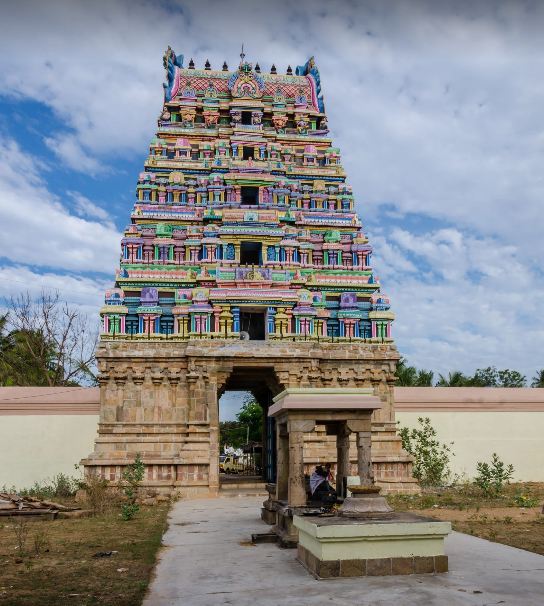Sivapuram Sri Sivagurunathaswamy Temple, Thanjavur

Address
Sivapuram Sri Sivagurunathaswamy Temple, Sivapuram Post, Sakkottai Via, Kumbakonam Taluk, Tanjore District, Tamil Nadu – 612 401.Ph:+91 – 98653 06840, 9698460984 and 89736 21938.
Deity
Sri Sivagurunathar, Sri Sivapuranathar, Sri Brahmapurinathar Amman: Sri Singaravalli, Sri Aaryambal
Introduction
The Sivagurunathaswamy temple one of the Padal petra stalam, Hindu God, Shiva temples revered by 7th Century poets mentioned in the Tevaram. It is located in Sivapuram near Kumbakonam. Sivapuram is located 5 kilometres south-east of the town and taluk headquarters of Kumbakonam on the way to Thiruvarur. Sivapuram is famous for the Sivagurunathaswamy temple dedicated to the Hindu god Shiva. The deity is also referred to as Sivagurunathar or Sivapuranathar. The temple is one of the 67 sthalams or holy abodes mentioned in the Thevaram located in the ancient Chola kingdom. According to different legends, Vishnu, Brahma and Kubera had worshipped Shiva here at different times. As Kubera is believed to have worshipped here, the village is also known as Kuberapuri. Theertham (Holy water) Chandra Theertham and Surya Theertham Sthala Vriksham (Sacred Tree): Senbagam
Puranic Significance
- Name & Historical Significance
- The name “Sivapuram” itself contains Lord Shiva’s name.
- Historical names: Kuberapuram, Bhookailayam, Sanbakaaranyam.
- The temple is under the administration of HR&CE, Government of Tamil Nadu.
- Legend of Lord Mahavishnu & Varaha Avatar
- During a deluge, Lord Mahavishnu prayed to Lord Shiva and took the Varaha Avatar (Swetha Varahar – White Boar).
- He lifted the submerging earth on his head and later came to Sivapuram to worship Lord Shiva.
- Lord Shiva restored Mahavishnu to his original form.
- A relief sculpture (Pudai Sirpam) depicting this legend is seen near Dakshinamurthy’s shrine.
- This event is mentioned in the hymns of Saint Thirugnanasambanthar and Saint Thirunavukkarasar.
- Legend of Kuberan & Nandhi’s Curse
- Ravana attempted to enter the temple for worship without performing rituals.
- Nandhi blocked his entry, leading to an argument where Kuberan intervened.
- Nandhi cursed Kuberan to be born on earth as a greedy king named Thalapathy.
- Kuberan later became a devotee of Lord Shiva and worshipped at this temple.
- Greedy King & Shivarathri Incident
- King Thalapathy found a copper plate inscription stating that on a Shivarathri day (Maasi month, Monday, Pradosham), a person sacrificing a male child would gain immense wealth.
- He bought a child from a poor couple and attempted to perform the ritual.
- The child prayed to Goddess Parvathy, who pleaded with Lord Shiva to save him.
- Lord Shiva revealed that this was a ploy to relieve Kuberan from the curse.
- The couple were actually Lord Indra & Indrani, and the child was Agni.
- Lord Shiva stopped the sacrifice, forgave Kuberan, and removed his curse.
- A crack and a bloodstain are visible on the temple’s Shivalingam to mark this event.
- Saint Thirugnanasambanthar’s Devotion
- He realized that innumerable Shivalingams were buried underground.
- To avoid stepping on sacred ground, he and his followers performed Angaprathakshanam (rolling around the temple).
- He sang his Pathigam (hymn) from outside the temple at a spot now called “Swamigal Thurai”.
- Even today, devotees perform Angaprathakshanam at the temple.
- Divine Worshippers of the Temple
- Lord Mahavishnu, Kuberan, Saint Thirugnanasambanthar, Saint Thirunavukkarasar (Appar), Ravana, Pattinathar, Arunagirinathar have worshipped Lord Shiva here.
Beliefs
Worshiping the lord here on Deepavali during Kubera Pooja is believed to bring prosperity to devotees. “Angaprathatchanam” is famous in this temple and devotees believe that by doing this, they will be relieved from illnesses and their legal battles will be resolved in their favour. Devotees worship Lord Kala Bairavar here to seek his help in overcoming their difficulties.
Special Features
Other than the shrines of Lord Shiva and Goddess Parvathy, shrines and idols of Vinayakar, Murugan with his consorts, Gajalakshmi, Theyu Lingam, Vayu Lingam, Pruthvi Lingam, Balamurugan, Bairavar (2), Chandran (2), Suryan, Saneeswarar, Mahavishnu ,Chandikeswarar and procession idols of other deities can be seen in the main hall and the corridors. Agni, Indrani, Indran and Kuberan are placed here in the form of lingam. In the “koshtam” (place surrounding the sanctum sanctorum), idols of Dakshinamurthy, Lingothbavar, Brahma and Vishnu Durgai can be seen. Idols of Nalvar can also be seen here. Sundarar can be seen along with his wife Paravai Natchiyar. There is a separate south-facing shrine for Kala Bairavar in the outer corridor.
Festivals
Aani Thirumanjanam in the Tamil month of Aani (June-July), Aadi Pooram in the Tamil month of Aadi (July-Aug), Vinayakar Chaturthi in the Tamil month of Aavani (Aug-Sept), Navarathri in the Tamil month of Purattasi (Sept-Oct),
Century/Period/Age
1000 to 2000 years old
Managed By
Hindu Religious and Charitable Endowments (HRCE)
Nearest Bus Station
Sivapuram
Nearest Railway Station
Kumbakonam
Nearest Airport
Trichy




